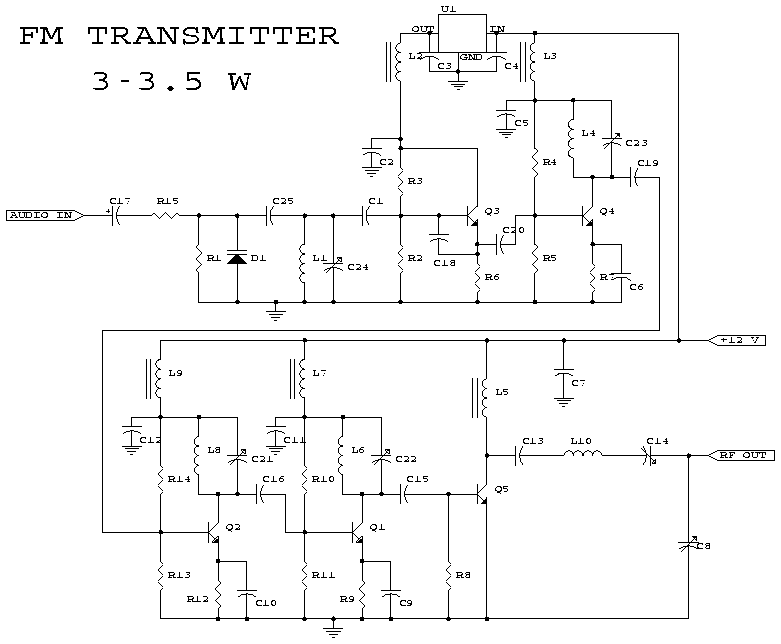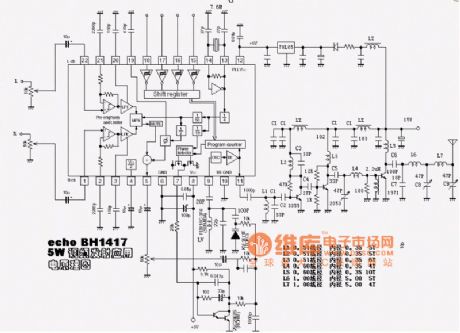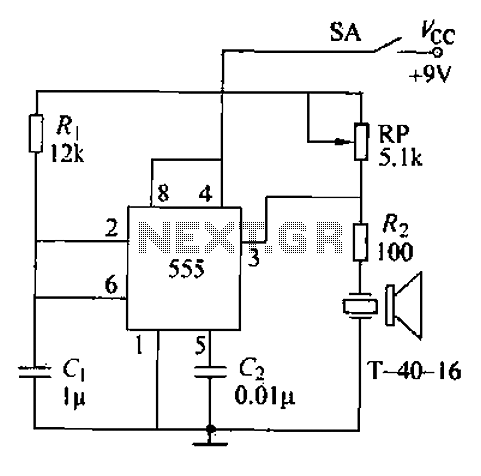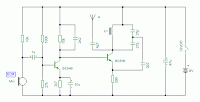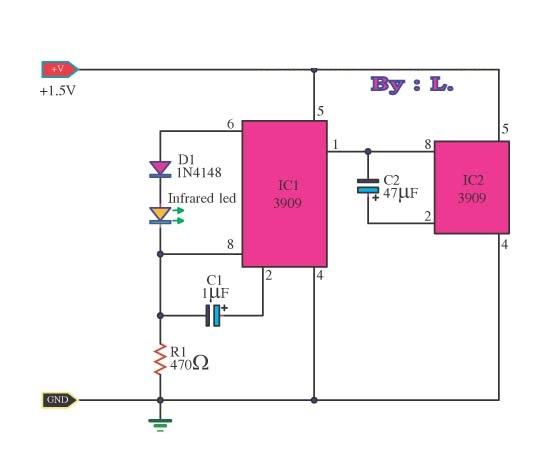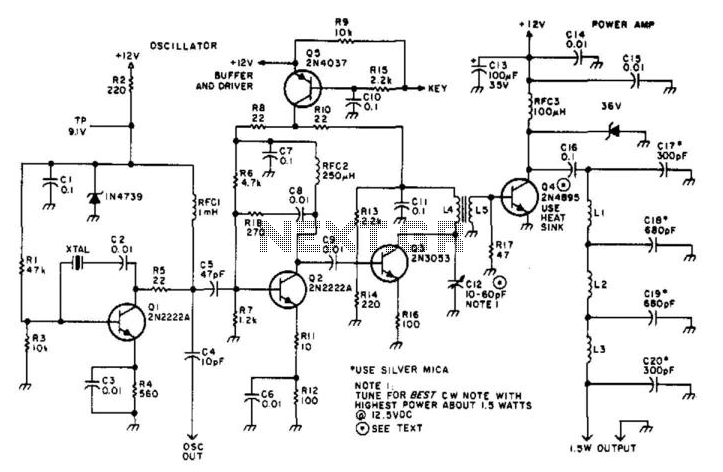
FM Transmitter
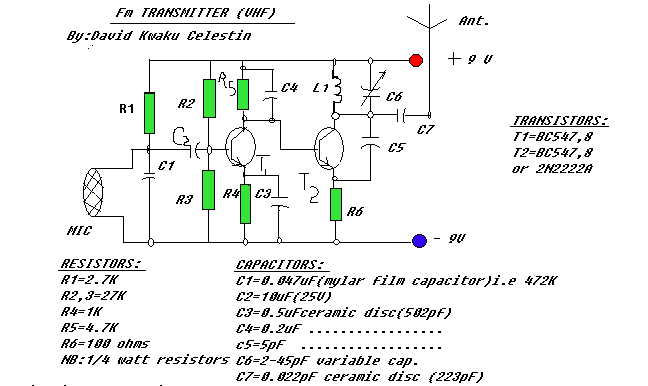
This simple transmitter operates from a 9V battery as shown above. It was built to address the challenges faced by a singing group using FM microphones in a church setting. The choir performs in an a cappella style, and the congregation expects high-quality sound. The previous FM microphone system was inadequate, which led to the development of this kit along with a mixer for the receivers. The design incorporates three separate transmitter circuits and a mixer on the receiver side, resulting in clear and accurate reproduction of the choir's voices. Experimental notes indicate that capacitor C3 is critical for circuit stability; without it, the circuit may become unstable. Capacitor C4 is connected in parallel with C5, providing a moderate load impedance. All transistors used in the circuit are of the NPN type. The circuit has demonstrated reliable performance. Based on the specified values, the inductance of inductor L1 can be calculated. The inductor has a diameter of 5.5 mm (0.22 inches), a radius of 0.11 inches (half the diameter), a length of 4.5 mm, and consists of 6 turns.
The transmitter circuit is designed to operate efficiently with a 9V power supply, making it suitable for portable applications. The use of three separate transmitter circuits allows for enhanced signal clarity and reduces the likelihood of interference, which is particularly important in environments with multiple audio sources. The mixer connected to the receivers enables seamless integration of the transmitted signals, ensuring that the choir's performance is captured accurately.
Capacitor C3 plays a vital role in maintaining the stability of the circuit by preventing oscillations that could lead to signal distortion. The design's reliance on NPN transistors offers advantages in terms of switching speed and gain, contributing to the overall performance of the transmitter.
The inductance of L1 can be calculated using the formula for a solenoid, which considers the number of turns, the length of the coil, and the diameter. This calculation is essential for determining the resonant frequency of the circuit, which directly impacts the quality of the transmitted audio signal. Proper tuning of L1 is critical to achieving optimal performance, ensuring that the transmitter operates within the desired frequency range for FM transmission.
Overall, this transmitter design represents a practical solution for enhancing audio quality in live performance settings, addressing the specific needs of the choir and congregation while ensuring reliability and clarity in sound reproduction.This simple transmitter operates from a 9V battery as shown above. I personally built this for a purpose. This is how it happened:- "members of my singing group find it difficult to handle a FM mic in Church. The choir sings in acapella form and the congregation expect us to perform well. The old FM mic system was not a perfect solution, so I buil t this kit and a mixer for the receivers. using three separate transmitter circuits and a mixer on the receiever, the choir voices were perfect and cleanly reproduced. " From the notes I made experimentally, C3 is vital to the circuit and without it the circuit may become unstable.
C4 is in parallel with C5 and presents a moderate load impedance. Finally all transistors are NPN. The circuit works well and has proved reliable. Using the above values, the inductance of L1 can be calculated. A diameter of 5. 5mm = 0. 22 inches, the radius is half this value or 0. 11 inch, the length is 4. 5mm and number of turns, n = 6. This gives L1 a value of: 🔗 External reference
The transmitter circuit is designed to operate efficiently with a 9V power supply, making it suitable for portable applications. The use of three separate transmitter circuits allows for enhanced signal clarity and reduces the likelihood of interference, which is particularly important in environments with multiple audio sources. The mixer connected to the receivers enables seamless integration of the transmitted signals, ensuring that the choir's performance is captured accurately.
Capacitor C3 plays a vital role in maintaining the stability of the circuit by preventing oscillations that could lead to signal distortion. The design's reliance on NPN transistors offers advantages in terms of switching speed and gain, contributing to the overall performance of the transmitter.
The inductance of L1 can be calculated using the formula for a solenoid, which considers the number of turns, the length of the coil, and the diameter. This calculation is essential for determining the resonant frequency of the circuit, which directly impacts the quality of the transmitted audio signal. Proper tuning of L1 is critical to achieving optimal performance, ensuring that the transmitter operates within the desired frequency range for FM transmission.
Overall, this transmitter design represents a practical solution for enhancing audio quality in live performance settings, addressing the specific needs of the choir and congregation while ensuring reliability and clarity in sound reproduction.This simple transmitter operates from a 9V battery as shown above. I personally built this for a purpose. This is how it happened:- "members of my singing group find it difficult to handle a FM mic in Church. The choir sings in acapella form and the congregation expect us to perform well. The old FM mic system was not a perfect solution, so I buil t this kit and a mixer for the receivers. using three separate transmitter circuits and a mixer on the receiever, the choir voices were perfect and cleanly reproduced. " From the notes I made experimentally, C3 is vital to the circuit and without it the circuit may become unstable.
C4 is in parallel with C5 and presents a moderate load impedance. Finally all transistors are NPN. The circuit works well and has proved reliable. Using the above values, the inductance of L1 can be calculated. A diameter of 5. 5mm = 0. 22 inches, the radius is half this value or 0. 11 inch, the length is 4. 5mm and number of turns, n = 6. This gives L1 a value of: 🔗 External reference
